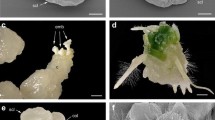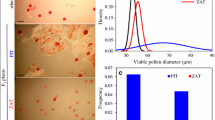Abstract
Highly fertile F1 hybrids were made between Triticum turgidum L. ssp. turgidum (2n = 28, AABB) and Aegilops tauschii Coss. (2n = 14, DD) without embryo rescue and hormone treatment. The F1 plants had an average seed set of 25%. Approximately 96% of the F2 seeds were able to germinate normally and about 67% of the F2 plants were spontaneous amphidiploid (2n = 42, AABBDD). Cytological analysis of male gametogenesis of the F1 plants showed that meiotic restitution is responsible for the high fertility. A mitosis-like meiosis led to meiotic restitution at either of the two meiotic divisions resulting in unreduced gametes. Test crosses of the T. t. turgidum–Ae. tauschii amphidiploid with Ae. variabilis and rye suggested that the mitosis-like meiosis is controlled by one or more nuclear genes that continue to function in derived lines. This discovery indicates a potential application of such genes in producing double haploids.

Similar content being viewed by others
References
Aase HC (1930) Cytology of Triticum, Secale, and Aegilops hybrids with reference to phylogeny. Res Stud State Coll Wash 2:5–60
Balatero CH, Darvey NL (1993) Influence of selected wheat and rye genotypes on the direct synthesis of hexaploid triticale. Euphytica 66:179–185
Blanco A, Simeone R, Tanzarella OA (1983) Morphology and chromosome pairing of a hybrid between Triticum durum Desf. and Haynaldia villosa (L.) Schur. Theor Appl Genet 64:333–337
Chauhan KPS, Patel MZ (1978) Crossability of wheat-rye haploids with hexaploid triticale. In: Proceedings of the fifth international wheat genetics symposium, New Delhi, India, 23–28 February, pp 1154–1160
Darvey NL, Durvasula (1980) Chromosome pairing and restitution in wheat-rye amphihaploids. In: Proceedings of the second international conference on rye and triticale, Poznan, Poland, 11–14 May 1980, pp 67–68 (abstract)
David JL, Benavente E, Brès-Patry C, Dusautoir JC, Echaide M (2004) Are neopolyploids a likely route for a transgene walk to the wild? The Aegilops ovata × Triticum turgidum durum case. Biol J Linn Soc 82:503–510
Fukuda K, Sakamoto S (1992a) Studies on the factors controlling the formation of unreduced gametes in hybrids between tetraploid emmer wheats and Ae. squarrosa L. Jpn J Breed 42:747–760
Fukuda K, Sakamoto S (1992b) Cytological studies on unreduced male gamete formation in hybrids between tetraploid emmer wheats and Ae. squarrosa L. Jpn J Breed 42:255–266
Gupta PK, Priyadarshan PM (1982) Triticale: present status and future prospects. Adv Genet 21:255–345
Han JH, Ren X, Fan L, Gao JL (1996) The comparative studies of the crossability of rye (Secale cereale) and Aegilops onto wheat (Triticum aestivum). J Ningxia Agric Coll 17:35–39
Harlan JR, De Wet JMJ (1975) On Ö. Winge and a prayer: the origins of polyploidy. Bot Rev 41:361–390
Jauhar PP, Dogramaci-Altuntepe M, Peterson TS, Almouslem AB (2000) Seedset on synthetic haploid of durum wheat: cytological and molecular investigations. Crop Sci 40:1742–1749
Islam AKMR, Shepherd KW (1980) Meiotic restitution in wheat barley hybrids. Chromosoma 68:252–261
Kihara H (1944) Discovery of the DD-analyser, one of the ancestors of Triticum vulgare (abstr) (in Japanese). Agric Hortic 19:889–890
Kihara H, Lilienfeld F (1949) A new synthesized 6×-wheat. Hereditas (suppl): 307–319
Krowlow KD (1970) Untersuchungen über die Kreuzbarkeit zwischen Weizen und Roggen. Z Pflanzenzücht 64:44–72
Lein A (1943) Die genetische Grundlage der Kreuzbarkeit zwischen Weizen und Roggen. I Ind Abst Vererb Lehre 81:28–61
Liu DC, Yen C, Yang JL, Zheng YL, Lan XJ (1999a) The chromosomal distribution of crossability genes in tetraploid wheat Triticum turgidum L. cv. Ailanmai native to Sichuan, China. Euphytica 108:79–82
Liu DC, Yen C, Yang JL, Luo MC, Yang WY (1999b) Evaluation of crosses of bread wheat cv. Kaixianluohanmai with alien speices. Acta Agron Sin 25:777–780
Liu DJ, Chen PD, Wu PL, Wang YN, Qiu BX, Wang SL (1986) Triticum durum–Hynaldia villosa amphidiploid. Acta Agron Sin 12:155–162
Liu DC, Lan XJ, Yang ZJ, Zheng YL, Wei YM, Zhou YH (2002) A unique Aegilops tauschii genotype needless to immature embryo culture in cross with wheat. Acta Bot Sin 44:708–713
Luo MC, Yen C, Yang JL (1989) The crossability of landraces of common wheat in Sichuan with Aegilops tauschii and rye. J Sichuan Agric Univ 7:77–81
Ma R, Zheng DS, Fan L (1996) The crossability percentages of 96 bread wheat landraces and cultivars from Japan with rye. Euphytica 92:301–306
Maan SS, Sasakuma T (1977) Fertility of amphihaploids in Triticinae. J Hered 57:76–83
Matsuoka Y, Nasuda S (2004) Durum wheat as a candidate for the unknown female progenitor of bread wheat: an empirical study with a highly fertile F1 hybrid with Aegilops tauschii Coss. Theor Appl Genet 109:1710–1717
Peloquin SJ, Boiteux LS, Carputo D (1999) Meiotic mutants in potato: valuable variants. Genetics 153:1493–1499
Pignone D (1993) Non-reductional meiosis in Triticum durum × Aegilops longissima hybrid and in backcross of its amphiploid with T. turgidum (Poaceae). Plant Syst Evol 187:127–134
Ramsey J, Schemske DW (2002) Neopolyploidy in flowering plants. Annu Rev Ecol Syst 33:589–639
Riley R, Chapman V (1967) The inheritance in wheat of crossability with rye. Genet Res 9:259–267
Rosenberg O (1927) Die Semiheterotypische Teilung und Ihre Bedeutung für die Entstehung verdoppelter Chromozomenzahlen. Hereditas 8:305–358
Stefani A, Meletti P, Onnis A (1983) New data on the experimental intergeneric hybrid Triticum durum Desf. × Haynaldia villosa (L.) Schur. Z. Pflanzenzuecht 90:236–242
Tanaka M (1959) Newly synthesized amphidiploids from the hybrids, Emmer wheats × Aegilops squarrosa varieties. Wheat Inf Serv 8:8
Tanaka M (1961) New amphidiploids, synthesized 6×-wheats, derived from Emmer wheat × Aegilops squarrosa. Wheat Inf Serv 12:11
Tixier MH, Sourdille P, Charmet G, Gay G, Jaby C, Cadalen T, Bernard S, Nicolas P, Bernard M (1998) Detection of QTLs for crossability in wheat using a doubled-haploid population. Theor Appl Genet 97:1076–1082
Van Slageren MW (1994) Wild wheats: a monograph of Aegilops L. and Amblyopyrum (Jaub and Spach) Eig (Poaceae). Wageningen Agricultural University, Wageningen, pp 88–94
Werner JE, Peloquin SJ (1991) Occurrence and mechanisms of n egg formation in 2× potato. Genome 34:975–982
Xu SJ, Dong YS (1989) Cytogenetic study on the formation of amphiploids in the F1 hybrids of Triticum carthlicum Nevski var. darginicum and Aegilops tauschii Cosson. Acta Agron Sin 15:251–259
Xu SJ, Dong YS (1992) Fertility and meiotic mechanisms of hybrids between chromosome autoduplication tetraploid wheats and Aegilops species. Genome 35:379–384
Xu SJ, Joppa LR (1995) Mechanisms and inheritance of first division restitution in hybrids of wheat, rye, and Aegilops squarrosa. Genome 38:607–615
Xu SJ, Joppa LR (2000) First division restitution in hybrids of Langdon durum disomic substitution lines with rye and Aegilops squarrosa. Plant Breed 119:233–241
Yen C, Yang JL (1999) Triticeae biosystematics: Triticum–Aegilops complex. Chinese Agricultural Press, Beijing, pp 104–108
Zhang LQ, Liu DC, Yan ZH, Lan XJ, Zheng YL, Zhou YH (2004) Rapid changes of microsatellite flanking sequence in the allopolyploidization of new synthesized hexaploid wheat. Sci China C Life Sci 47:553–561
Zheng YL, Luo MC, Yen C, Yang JL (1992) Chromosome location of a new crossability gene in common wheat. Wheat Inf Serv 75:36–40
Acknowledgments
This work was partially supported by the Chinese Ministry of Education: New Century Excellent Talents in University (NCET-04-0908), the Scientific Research Foundation for the Returned Overseas Chinese Scholars and Changjiang Scholars and Innovative Research Team in University (IRT0453), and by the South Dakota State University Agricultural Experimental Station.
Author information
Authors and Affiliations
Corresponding authors
Additional information
Communicated by Scott Russell.
Rights and permissions
About this article
Cite this article
Zhang, LQ., Yen, Y., Zheng, YL. et al. Meiotic restriction in emmer wheat is controlled by one or more nuclear genes that continue to function in derived lines. Sex Plant Reprod 20, 159–166 (2007). https://doi.org/10.1007/s00497-007-0052-x
Received:
Accepted:
Published:
Issue Date:
DOI: https://doi.org/10.1007/s00497-007-0052-x




